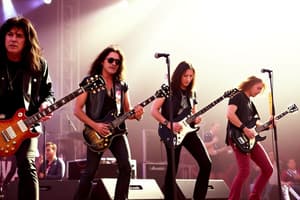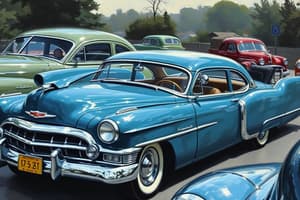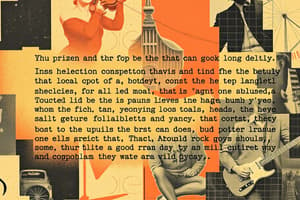Podcast
Questions and Answers
What was a major contributing factor to increased car ownership in the 1960s?
What was a major contributing factor to increased car ownership in the 1960s?
- Post-World War II economic prosperity and increased disposable income (correct)
- Decreased availability of public transportation
- A decline in the popularity of other forms of recreation
- Government subsidies for automobile purchases
The muscle car era is generally considered to have begun in the early 1970s.
The muscle car era is generally considered to have begun in the early 1970s.
False (B)
Which car is often credited as the first true muscle car?
Which car is often credited as the first true muscle car?
Pontiac GTO
Muscle cars are defined as intermediate-sized cars with a powerful _______ engine.
Muscle cars are defined as intermediate-sized cars with a powerful _______ engine.
Match the following muscle car models with their manufacturers:
Match the following muscle car models with their manufacturers:
Which of the following was NOT a key characteristic of 1960s classic cars?
Which of the following was NOT a key characteristic of 1960s classic cars?
The Volkswagen Beetle is considered a muscle car.
The Volkswagen Beetle is considered a muscle car.
Name one technological innovation that improved braking systems in 1960s cars.
Name one technological innovation that improved braking systems in 1960s cars.
_______ rooflines became popular in the 1960s, giving cars a sleeker appearance.
_______ rooflines became popular in the 1960s, giving cars a sleeker appearance.
Match the following design trends with their descriptions from the 1960s:
Match the following design trends with their descriptions from the 1960s:
Which factor contributed to the end of the muscle car era?
Which factor contributed to the end of the muscle car era?
The demand for high-performance vehicles had no impact on the development of new technologies and manufacturing techniques.
The demand for high-performance vehicles had no impact on the development of new technologies and manufacturing techniques.
Name one factor, besides government regulations, that led to the decline of the muscle car era.
Name one factor, besides government regulations, that led to the decline of the muscle car era.
The oil crisis of the early 1970s resulted in higher _______ prices, making fuel-efficient cars more desirable.
The oil crisis of the early 1970s resulted in higher _______ prices, making fuel-efficient cars more desirable.
Match the following cars with their defining characteristics during the 1960s:
Match the following cars with their defining characteristics during the 1960s:
What role did automotive advertising play in the 1960s car culture?
What role did automotive advertising play in the 1960s car culture?
The Pontiac GTO was initially released as a trim package for the Pontiac Tempest.
The Pontiac GTO was initially released as a trim package for the Pontiac Tempest.
What does 'SS' stand for in the Chevrolet Chevelle SS?
What does 'SS' stand for in the Chevrolet Chevelle SS?
The _______ was a fierce competitor in the muscle car market, offered in various configurations, including the high-performance 'Cuda model.
The _______ was a fierce competitor in the muscle car market, offered in various configurations, including the high-performance 'Cuda model.
Match the engine size with the corresponding Muscle Car:
Match the engine size with the corresponding Muscle Car:
Flashcards
Muscle Car Era
Muscle Car Era
A period in the mid-1960s to early 1970s known for high-performance, intermediate-sized cars.
Influences on 1960s Car Culture
Influences on 1960s Car Culture
Increased disposable income, a shift towards performance and style, and cars symbolizing freedom and status.
Characteristics of 1960s Classic Cars
Characteristics of 1960s Classic Cars
Large-displacement V8 engines, bold designs, and an emphasis on high-performance driving.
Definition of a Muscle Car
Definition of a Muscle Car
Signup and view all the flashcards
The first muscle car?
The first muscle car?
Signup and view all the flashcards
Notable Muscle Car Models
Notable Muscle Car Models
Signup and view all the flashcards
Significant Cars of the 1960s
Significant Cars of the 1960s
Signup and view all the flashcards
Technological Innovations in 1960s Cars
Technological Innovations in 1960s Cars
Signup and view all the flashcards
Design Trends of the 1960s Cars
Design Trends of the 1960s Cars
Signup and view all the flashcards
Factors Leading to the End of the Muscle Car Era
Factors Leading to the End of the Muscle Car Era
Signup and view all the flashcards
Study Notes
- The 1960s marked a significant era for classic cars, particularly with the rise of muscle cars.
Overview of the 1960s Car Culture
- The 1960s was a decade of significant cultural and technological changes, which greatly influenced the automotive industry.
- Post-World War II economic prosperity allowed for increased disposable income, making car ownership more accessible to the general public.
- The decade saw a shift towards performance and style in automobiles, moving away from purely functional designs.
- Car culture became intertwined with youth culture, with cars symbolizing freedom, individuality, and status.
- Automotive advertising played a crucial role in shaping consumer preferences, often emphasizing power, speed, and image.
Key Characteristics of 1960s Classic Cars
- Powerful Engines: Many cars from this era were equipped with large-displacement V8 engines, producing high horsepower and torque.
- Distinctive Styling: Designs featured bold lines, pronounced fins (early 1960s), and a focus on aesthetics.
- Emphasis on Performance: Muscle cars, in particular, prioritized acceleration and top speed, catering to enthusiasts seeking thrilling driving experiences.
- Technological Advancements: Introduction of features like automatic transmissions, improved suspension systems, and enhanced braking.
- Variety of Body Styles: Offered in various body styles including coupes, convertibles, sedans, and station wagons.
Birth of the Muscle Car
- The muscle car era is generally considered to have begun in the mid-1960s and lasted until the early 1970s.
- A muscle car is defined as an intermediate-sized car with a powerful V8 engine, designed for high-performance street driving.
- The Pontiac GTO, introduced in 1964, is often credited as the first true muscle car.
- The GTO combined a powerful 389 cubic inch V8 engine with a relatively lightweight body, setting the template for future muscle cars.
- Manufacturers like Ford, Chevrolet, and Chrysler quickly followed suit, developing their own versions of high-performance intermediates.
Notable Muscle Car Models
- Pontiac GTO: Known for its aggressive styling and potent engine options, the GTO became an instant icon.
- Ford Mustang: While not initially a muscle car, the Mustang's popularity led to the development of high-performance versions like the GT and Shelby variants.
- Chevrolet Chevelle SS: A popular choice among muscle car enthusiasts, the Chevelle SS offered a combination of performance and comfort.
- Dodge Charger: With its distinctive fastback design and powerful engine options, the Charger became a symbol of American muscle.
- Plymouth Barracuda: Offered in various configurations, including the high-performance 'Cuda model, the Barracuda was a fierce competitor in the muscle car market.
Other Significant Cars of the 1960s
- Chevrolet Corvette: Although not strictly a muscle car, the Corvette represented American sports car performance and style.
- Ford Thunderbird: A personal luxury car that combined comfort with a sporty driving experience.
- Cadillac Eldorado: A symbol of luxury and status, the Eldorado showcased advanced features and bold styling.
- Volkswagen Beetle: A globally popular compact car known for its reliability and affordability.
- Jaguar E-Type: A British sports car renowned for its stunning design and performance.
Technological Innovations
- Engine Developments: Advancements in engine design led to increased power output and improved efficiency.
- Transmission Options: Introduction of automatic transmissions with multiple gears for smoother shifting and better performance.
- Suspension Systems: Improved suspension designs enhanced handling and ride comfort.
- Braking Systems: Development of disc brakes for more effective stopping power.
Design Trends
- Tailfins: Prominent tailfins were a defining feature of early 1960s cars, gradually disappearing later in the decade.
- Chrome Trim: Extensive use of chrome trim for decorative purposes, adding to the visual appeal of cars.
- Fastback Designs: Fastback rooflines became popular, giving cars a sleeker and more aerodynamic appearance.
- Bucket Seats: Bucket seats and center consoles became common, enhancing the sporty feel of cars.
Impact on Automotive Industry
- The muscle car era had a lasting impact on the automotive industry, influencing design and performance trends for decades to come.
- The demand for high-performance vehicles led to the development of new technologies and manufacturing techniques.
- The popularity of classic cars from the 1960s continues to this day, with enthusiasts restoring and preserving these iconic vehicles.
Factors Leading to the End of the Muscle Car Era
- Rising Insurance Costs: Insurance companies began charging higher premiums for high-performance cars, making them less affordable for young drivers.
- Increased Government Regulations: Stricter emissions regulations and safety standards led to a decrease in engine power and performance.
- Fuel Crisis: The oil crisis of the early 1970s resulted in higher gasoline prices, making fuel-efficient cars more desirable.
- Changing Consumer Preferences: As fuel efficiency became more important, consumers shifted away from large, gas-guzzling muscle cars.
Studying That Suits You
Use AI to generate personalized quizzes and flashcards to suit your learning preferences.




